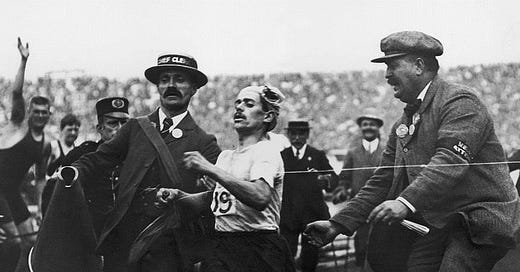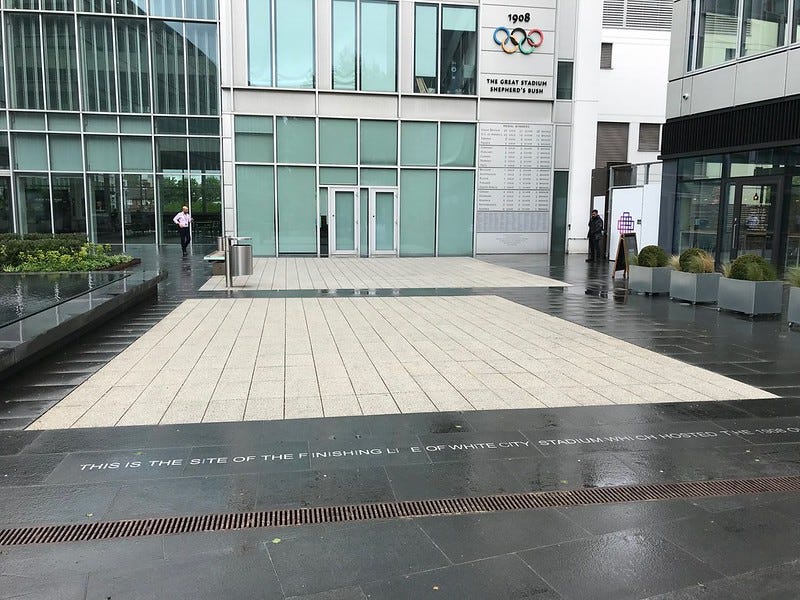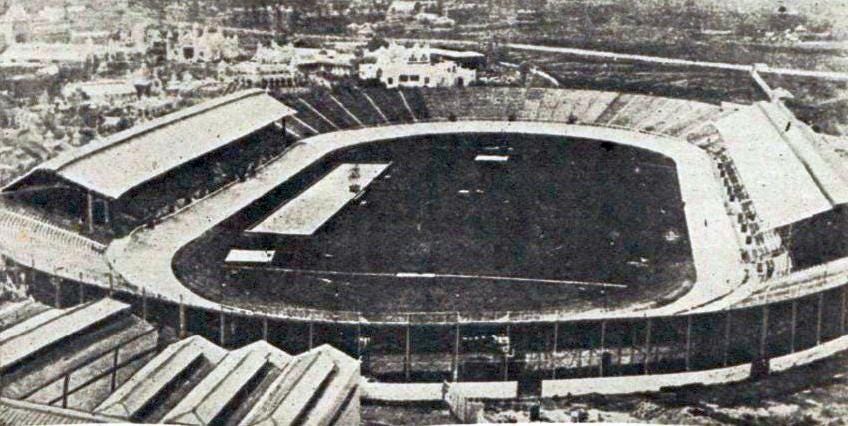Welcome to Londonist: Time Machine’s Friday instalment for paying subscribers, with a generous teaser for everyone else.
As the 2024 Olympics draws to a close, I thought it apposite to cover one final sporting incident from London’s history. This is the tale of the first standard-length marathon, which finished in the world’s largest stadium and produced one of the Olympics’ greatest controversies. A story of sporting superlatives if ever there was one.
That’s for the main feature, but first the History Radar…
History Radar
Upcoming events for those interested in London history.
🏭 KENTISH TOWN TALK: The changing face of Kentish Town is the subject of a free talk at Guildhall Library on 13 August. Origins, industry, retail, transport, class, immigration and public figures all feature in the whistlestop tour from the medieval period through to today. Watch in person at Guildhall Library, or online.
📗 CITY BY THE BOOK: On 14 August, the busy Guildhall Library offers a guided walk through the Square Mile, focusing on the many authors and poets who have been inspired by the area. City of London Guide and Lecturer Jill Finch takes you past the skyscrapers of the Financial District, looking beyond the money and power of the area today. Starts near St Paul's tube station.
🧜♀️ QUEER AS FOLKLORE: Also on 14 August, the Queen's House in Greenwich stays open late for an evening celebrating new book Queer as Folklore, by writer, historian and community organiser Sacha Coward. Hear about examples of mermaids and pirates in the museum's own collection, and queer histories of folklore more broadly, and learn about "female sailors", people raised as women who went on to sail as men in the 19th century.
👑 PLANTAGENET KINGS: The story of the power struggle between the first Plantagenet king, Henry II, and his four sons is told in an online talk hosted by the National Archives. Historian Nick Barratt explores how Henry II and the next two generations of his family governed England, while at war with themselves. This one’s also on 14 August.
🍓 TWILIGHT TOUR: Strawberry Hill House stays open late for special twilight tours on 15 August. Begin with a drink, then join a guide on a walk through Horace Walpole's gothic castle in Twickenham.
💥 HITLER'S VENGEANCE: The London Archives marks 80 years since the beginning of German 'Vengeance Attacks' on London in June 1944. London County Council bomb damage maps, police photos, civilian diaries and other sources are used as the basis for this talk on 16 August about how Londoners responded to the 'revenge weapons' which fell on the capital.
🚌 IMBERBUS: Alright, so it's not in London, but it's a top-notch and very popular event featuring London buses, so indulge us for a second. Imberbus (17 August) is your chance to join an annual parade of double-decker London buses from Warminster to Chitterne, via Salisbury Plain and a collection of bucolic villages. Why? It all dates back to residents of the small village of Imber being turfed out of their village by the Ministry of Defence (MoD) in 1943, and never being allowed to return — full story here.
🏥 FLORENCE NIGHTINGALE'S LONDON: Also on 17 August, join a guide from the Florence Nightingale Museum on a walk visiting London locations linked to the pioneering nurse. Begin on Park Lane, and pass the house where she spent her last days, the hotel where she wrote Notes on Nursing, the statue of the Lady with the Lamp, and the hospital where she founded her nursing school.
👩🏾🦱 BLACK HISTORY QUIZ: Pit your wits against other history and trivia buffs in a quiz about Black British history on 17 August, hosted by The History Hotline podcast. The quiz takes place at popular Deptford venue Buster Mantis and is hosted by award-winning writer and presenter Chanté Joseph.
🏞️ CRYSTAL PALACE MUSEUM: Sunday's the only day of the week that the Crystal Palace Museum opens; see scale models of the spectacular building that once stood on this spot, and admire photos and souvenirs from a time when it was one of London's biggest tourist attractions.
London’s Great Olympic Lie?
What is the opposite of “glorious”? Is it “inglorious”? Or is it the White City Place corporate office complex on a wet summer’s day?
I’ve nothing against this west London commercial hub. I’m sure it has excellent office facilities and an industry-leading commitment to sustainability. It certainly boasts a pleasant branch of Coco di Mama, from which I’m typing some of these words. But glorious it ain’t.
Look to the floor, though, and you’ll spot a token of erstwhile glory written across the flagstones:
“THIS IS THE SITE OF THE FINISHING LI E OF WHITE CITY STADIUM WHICH HOSTED THE 1908 OLYMPICS.”
Had you lurked on this spot 116 years ago, then you would have witnessed one of the greatest sporting controversies in Olympic history.
Scandal at the world’s biggest stadium
London was never supposed to host the 1908 Olympics. The chosen city of Rome was knocked akilter by the 1906 eruption of Mount Vesuvius. Naples was choked by ash clouds, while the Eternal City was crippled by the economic fallout. And so the Olympic baton was passed to London at very short notice.
The area chosen for our first Olympic Park was White City, an area of west London that is today neither white, nor a city. The curious name comes from the Franco-British Exhibition, also held here in 1908. This event marked the fourth anniversary of the Entente Cordiale, an agreement of cooperation and (whisper it) even friendship between Britain and France. The exhibition’s pavilions were whitewashed, whence the nickname that later became official. So official it’s now on the tube map.
The Olympic stadium had to be built with all haste. Somehow, the labourers of the day managed to erect the behemoth in just 10 months. At a reported capacity of 150,000, this was easily the biggest stadium in London, if not the world.
As you can see, it was relatively featureless, with two covered stands and a high perimeter fence. One curiosity, from a modern viewpoint, was the inclusion of a 100 metre swimming pool and diving board within the infield. Strange to imagine it now, but Olympic swimming was always held outdoors. It would not be until the Games returned to London in 1948 that the first indoor races were held, in what is now Wembley Arena.
Arguably, though, it was the marathon for which this Olympic venue is best remembered. Indeed, this was to be the marathon that set the measure for all future marathons. The route from Windsor Castle to the White City Stadium came in at “about 26 miles”, and the athletes then had to loop 385 yards (352 m) round the track to reach the finish line. That set distance of “about 26 miles and 385 yards” was later standardised to be precisely 26 miles and 385 yards. And it all began in west London (and Berkshire).






